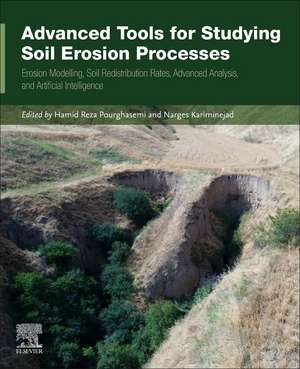Advanced Tools for Studying Soil Erosion Processes: Erosion Modelling, Soil Redistribution Rates, Advanced Analysis, and Artificial Intelligence
Editat de Hamid Reza Pourghasemi, Narges Kariminejaden Limba Engleză Paperback – 23 aug 2024
Organized into three parts: 1) Erosion processes and impacts, 2) Advanced computing techniques to quantify soil erosion, and 3) Methods of Soil Erosion, this book will be an invaluable source material for researchers, academicians, graduate and undergraduate students, and professionals in the field of geology, specifically focused on geographic information systems and remote sensing.
- Provides an overview of soil erosion and its interaction with natural hazards (i.e., geological, hydrological, meteorological, and biological)
- Introduces advanced tools and technologies in soil erosion management
- Presents future soil erosion opportunities and challenges
Preț: 824.08 lei
Preț vechi: 1080.80 lei
-24% Nou
Puncte Express: 1236
Preț estimativ în valută:
157.79€ • 162.77$ • 130.78£
157.79€ • 162.77$ • 130.78£
Carte tipărită la comandă
Livrare economică 13-27 februarie
Preluare comenzi: 021 569.72.76
Specificații
ISBN-13: 9780443222627
ISBN-10: 0443222622
Pagini: 632
Dimensiuni: 191 x 235 mm
Greutate: 0.45 kg
Editura: ELSEVIER SCIENCE
ISBN-10: 0443222622
Pagini: 632
Dimensiuni: 191 x 235 mm
Greutate: 0.45 kg
Editura: ELSEVIER SCIENCE
Cuprins
Part-I - Erosional processes and impacts 1. Mapping land subsidence using time-series analysis of Sentinel-1 InSAR in various land use areas 2. Use of hydrological models in erosion and sediment studies: a review 3. Comprehensive introduction to Digital Elevation Models, as a key dataset in soil erosion mapping 4. Eco-geomorphic reconstruction and illustration of the erosional landforms from a geomorphological point of view 5. Extraction of water bodies using machine learning and water body indices in an arid region, comparison, and application: A case study Naser Lake Egypt 6. Leveraging remote sensing data and machine learning models to estimate suspended sediment concentration (SSC), a vital water quality parameter to assess soil erosion effects 7. The messianic tail of cyanobacteria: Revival role of microbial biological crust on restoring degraded soils 8. Analyzing the homogeneity of the paired catchments using the fractal dimension of the drainage network and catchment shape 9. Fractal analysis of drainage network and its relationship with flooding potential in arid areas 10. Climate change and soil erosion dynamics: An overview 11. Mapping rangeland vegetation types sensitive to soil erosion in semi-arid of Iran Part-II - Advanced computing techniques to quantify soil erosion 12. Event-based soil erosion estimation in a tropical watershed using OpenLISEM 13. A scenario-based approach for modeling and monitoring the impacts of climate change on forest fire using MODIS time series images 14. Soil erosion analysis based on UAV and SPOT-6 satellite images 15. Gully erosion susceptibility assessment using machine learning methods and geostatistical multivariate approach 16. Land subsidence modeling and mapping in Darab region, Iran 17. Review of multihazards research with the basis of soil erosion 18. Prediction of soil erosion using machine learning 19. Artificial Intelligence including Machine Learning and Deep Learning algorithms 20. Understanding piping process on large dimension piping: Erosion versus weathering 21. Quantile random forest technique for soil moisture contents digital mapping, Sarvestan Plain, Iran 22. Modeling spatial variability of soil loss tolerance (T-value) using geostatistical approaches (case study: Dorudzan Watershed, Fars Province, Iran) Part-III - Methods of soil analysis 23. Potential of spectroscopy-based approaches for predicting soil erosion-related parameters: A short review 24. Spatiotemporal variations in land use of Mahvelat plain in Iran using Google Earth Engine from 2011 to 2030 25. Detecting soil salinization, sodicity, and alkalization hazards within cultivated lands using digital soil mapping approaches 26. The impact of geomorphological hazards (i.e., mass movements/landslides) on soil erosion 27. Involvement of erosion processes in the development of landslides in the locality of Echiock-Santchou (West Cameroon) 28. Digital mapping of soil pH in arid and semi-arid regions 29. Unraveling the spatial signature of gully erosion in the arid and semi-arid regions of the northeast of Iran: Every single factor matters! 30. Soil erosion monitoring using the perpendicular soil moisture index as a remote sensing index (case study: Salehiya Wetland, Iran) 31. Scrutinizing of soil erosion spatial distribution through explicit spatial HRU approaches in SWAT model 32. Application of ANSWERS model for calculating runoff and sediment prediction from steep agricultural watersheds in northern Iran and its comparison with the other related models 33. Susceptibility of the erosional landforms (Case study: Razavi Khorasan Province, Iran)
Index
Index
